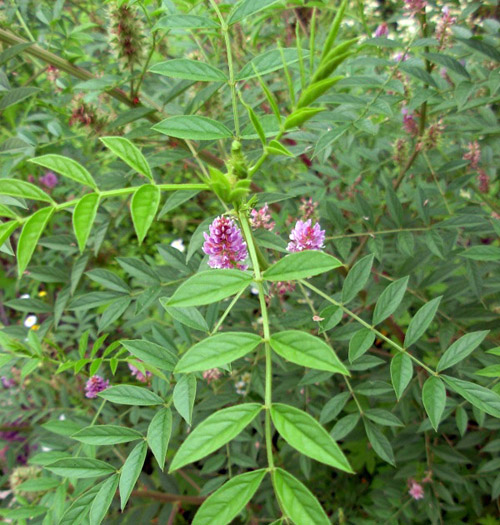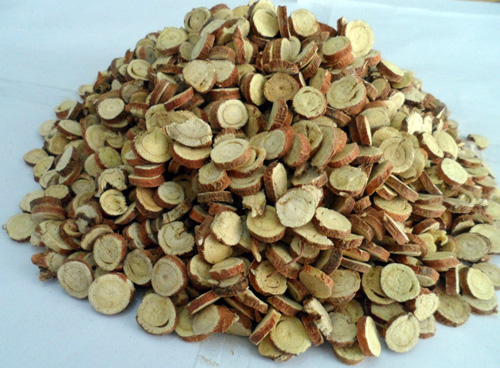The source is from the root of Glycyrrhiza uraleusis Fisch. Or G. grabra L., family Leguminosae. The medicinal material is mainly produced in Inner Mongolia, Shanxi, Gansu and Xinjiang of China, etc., and harvested in autumn. It is applied crudely or roasted with honey for use after being processed by removing the root, slicing and drying.
Medicinal Properties: Sweet in flavor, mild in nature, and attributive to the heart, lung, spleen and stomach meridians.
Actions: Enrich qi and invigorate the stomach and spleen, moisten the lung and resolve phlegm, clear away heat and toxin, relieve spasm and alleviate pain.

Application
1. It is used for syndromes of deficiency of heart-qi and spleen-qi. In the case with deficiency of heart-qi manifested as palpitation, spontaneous sweating and knotted or slow-regular-intermittent pulse, Zhigancao (Radix Glycyrrhizae, honey-fried) is mainly used together with Renshen ( Radix Ginseng), Maimendong ( Radix Trichosanthis), Guizhi (Ramulus Cinnamomi) and Ejiao (Colla Corii Asini), etc., such as Zhigancao Tang (Decoction); in the case due to deficiency of the spleen with fatigue, poor appetite or loose stool, it is used with Dangshen (Radix Codonopsis), Baizhu (Rhizoma Atractylodis Macrocephalae), etc., such as Sijunzi Tang (Decoction).
2. It is applied for cough and dyspnea. As it has the action of moistening the lung and resolving phlegm, it is indicated for many kinds or syndromes of cough and dyspnea. For a cough due to wind-heat, it is used together with Jiegeng ( Radix Platycodi), Qianhu ( Radix Peucedani), and Sangye Folium Mori), etc.; for that due to wind-cold, with Mahuang (Herba Ephedrae ), Xingren ( Semen Pruni Armeniacae), such as San'ao Tang (Decoction); for that due to lung-heat, with Shengshigao ( Gypsum Fibrosum ), Mahuang ( Herba F,phedrae ), Xingren ( Semen Pruni Armeniacae), etc., such as Ma Xing Shi Gan Tang (Decoction); for that due to stagnation of damp-phlegm, used with Banxia (Rhizoma Pinelliae), Fuling (Poria), etc..
3. It is applied for pyocutaneous disease, sore throat or drug and food poisoning. For pyocutaneous disease, it is used with Jinyinhua (Flos Lonicerae ), Lianqiao (Fructus Forsythiae) etc.; for sore throat, used with Jiegeng (Radix Platycodi), such as Jiegeng Tang (Decoction). For drug and food poisoning, thick decoction of Gancao (Radix Glycyrrhizae) should be given frequently, or combined with Lüdou (Semen Phaseoli Radiati ) and Fangfeng (Radix Saposhnikoviae), which are decocted for oral use when there is no particularly effective medicine for detoxification.

4. It is applied for spasm or pain of epigastric abdomen and limbs. In treating pain of epigastric abdomen, it is used with Guizhi (Ramulus Cinnamomi), Baishaoyao (Radix Paeoniae Alba ), and Yitang ( Saccharum cure Malto), etc., such as Xiao Jianzhong Tang (Decoction) for spasm and pain of limbs, used with Baishaoyao (Radix Paeoniae Alba), such as Shaoyao Gancao Tang (Decoction).
In addition, Gancao (Radix Glycyrrhizae) in a prescription exerts an effect on decreasing or moderating medicinal side-effects or toxicity and regulating actions of all other herbs.
Usage and Dosage:
2 -10 g or up to 10 -30 g is used in decoction when used as a dominant herb. It fits to be used crudely in the prescription for clearing or purging while the honey-roasted Gancao (Radix Glycyrrhizae) is used in the one for tonifying and nourishing.
Notes:
Contraindicated for the case with fullness of epigastric abdomen, vomiting or edema due to excessive dampness. And it should be avoided using for a long course and in large amount to prevent a case from having edema. Also, it is incompatible with Daji (Radix Euphorbiae Pekinensis ), Gansui ( Radix Euphorbiae Kansui) and Yuanhua (Flos Genkwa).







